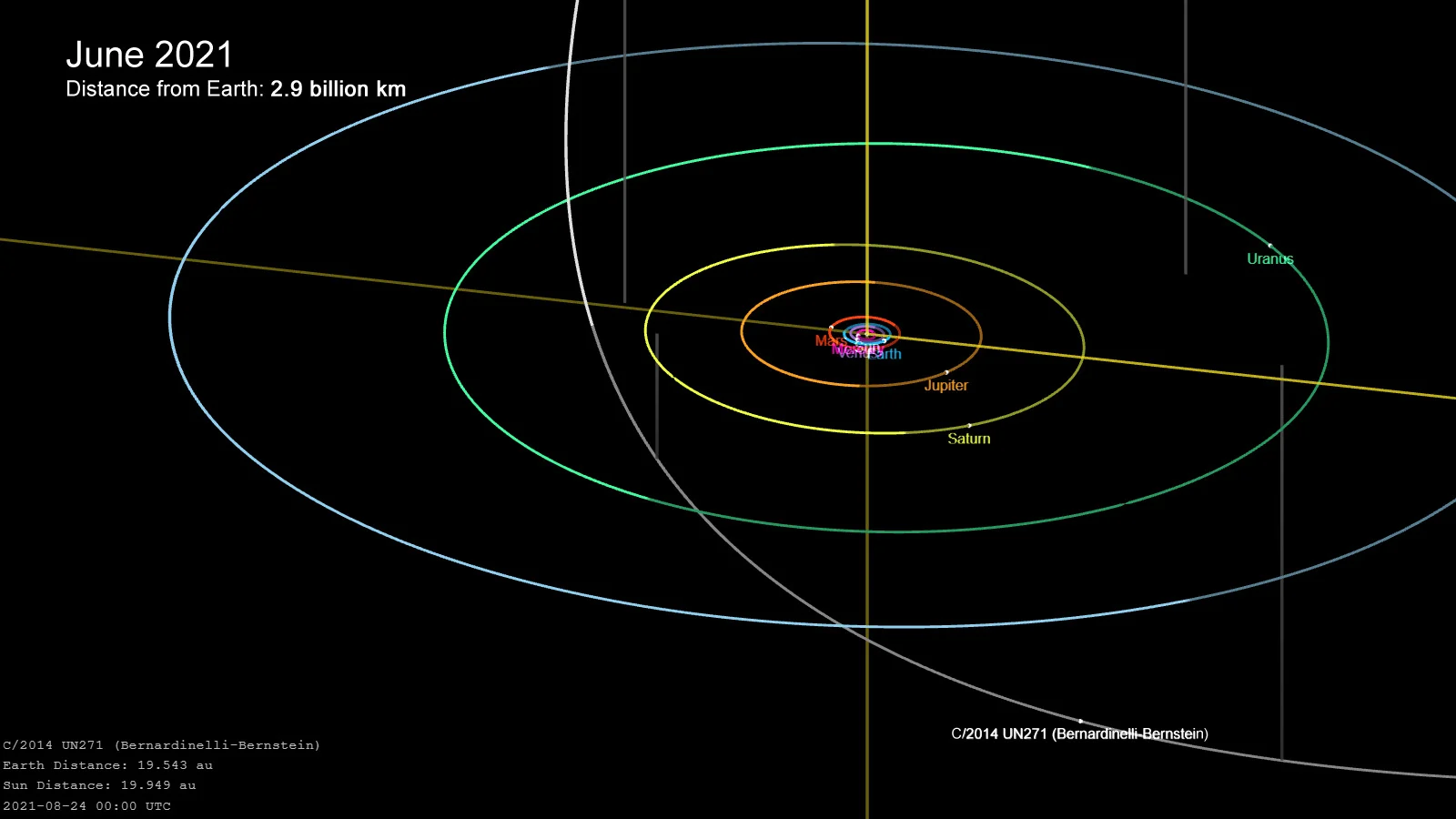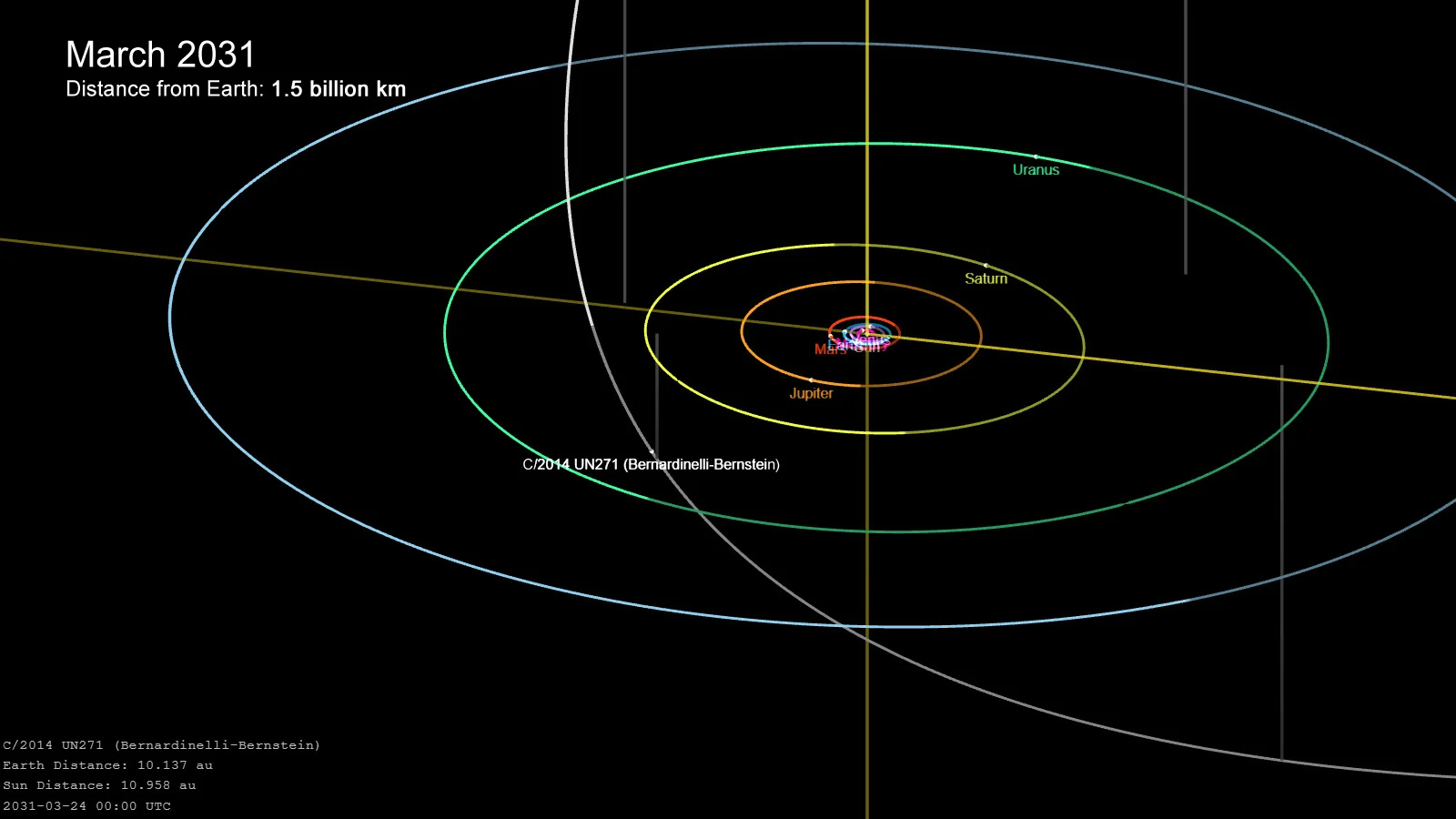
A giant 'mega-comet' is diving through our solar system
This may be the largest comet astronomers have ever found!
Astronomers discovered a never-before-seen comet plunging into the solar system from afar. From the looks of it, it's a giant!
On June 19, 2021, astronomers announced they had spotted a new object, far out from the Sun and far below the plane of the solar system. Shortly after that, new observations revealed that it had developed a gassy coma surrounding it. It was a new comet, originating from the Oort cloud, over 3 trillion kilometres out in space! That's over 700 times farther away than Neptune!

The position and orbital path of comet C/2014 UN271, as of June 24, 2021. Credit: NASA/JPL-Caltech
If that wasn't enough to make this discovery remarkable, estimates put its size at around 200 km across. If correct, that would make it the largest comet ever seen.
The newly-named comet is now called C/2014 UN271 (Bernardinelli-Bernstein). While it's a somewhat cumbersome moniker, this designation tells astronomers plenty about it — what it is, when it was discovered, and who first spotted it.

This artist conception drawing depicts a Trans-Neptunian Object, orbiting far from the Sun. Credits: Artwork - NASA, ESA, and G. Bacon (STScI). Science - NASA, ESA, and C. Fuentes (Harvard-Smithsonian Center for Astrophysics)
The comet's name starts with 2014 instead of 2021 because it isn't exactly new to us. Astronomers Pedro Bernardinelli and Gary Bernstein recently spotted it in the data collected by the Dark Energy Survey. However, the survey actually captured the first image of the comet back on October 20, 2014.
"Some people asked why it was only announced now," Bernardinelli said on Twitter shortly after the announcement. "Finding [Trans-Neptunian Objects] with [the Dark Energy Survey] is a massive computational problem (my Ph.D. was solving this problem). The search itself took 15~20 million CPU-hours, and the catalogue production from our 80,000 exposures probably took more than that!"
Bernardinelli called this a Trans-Neptunian Object or TNO. These are objects orbiting the Sun that spend most or all of their time beyond Neptune's orbit. Some other famous examples are 'binary planet' Pluto and Charon, and dwarf planets Sedna, Makemake, and Eris.
Unlike all of those other TNOs, though, 2014 UN271's orbit brings it much closer to the Sun. While it won't come anywhere close to Earth, when it reaches its nearest point to the Sun — sometime in early 2031 — it will be around 10.5 billion km away. That puts it beyond the orbit of Saturn.

The projected position of 2014 UN271, on March 24, 2031. Credit: NASA/JPL-Caltech
Also, unlike the other major objects in the solar system, which orbit more or less along with everything else in the ecliptic plane, 2014 UN271's orbit is almost perpendicular to the ecliptic. This is because the 'grasp' of the Sun's gravity on objects in the distant Oort cloud is weak and tenuous. There's simply not enough force to pull them down into the ecliptic plane as it did with nearly everything else closer to it over the past 4.5 billion years.
It's a sure bet that, between now and the late 2030s, there will be many telescopes pointed at 2014 UN271. Not only is this likely the largest comet astronomers have ever seen, but it will no doubt contain a treasure trove of information about the Oort cloud. It may even hold answers to questions about the birth of our solar system.

These two views of the orbit of 2014 UN271 are shown edge-on and from the side, revealing the high 'eccentricity' of its path around the Sun. Credit: NASA/JPL-Caltech/Scott Sutherland
There are already calls from the space community to plan (or reroute) a spacecraft mission to intercept this icy wanderer as it makes its close pass through the solar system. It could be one of our best opportunities to study an object from the Oort cloud up close.
As NASA engineer Tim Reyes said on Twitter, "While its closest point to the Sun is a little farther than Saturn, we could send a small flyby probe. Otherwise, the Oort Cloud region is a 100+ year journey."











